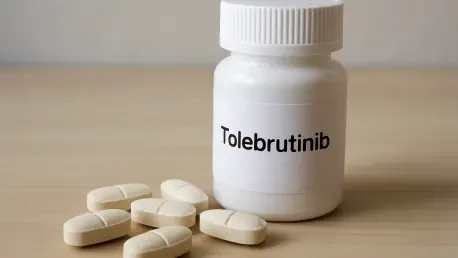In the fast-paced realm of pharmaceutical advancements, few stories capture attention like the regulatory journey of Sanofi’s tolebrutinib, a potential game-changer for non-relapsing secondary progressive multiple sclerosis (nrSPMS). This Bruton’s tyrosine kinase (BTK) inhibitor, aimed at slowing the relentless disability progression in a challenging form of MS, has encountered a significant hurdle with the US Food and Drug Administration (FDA) pushing its approval decision from late September to December 28 of this year. Such a delay raises pressing questions about the drug’s future, the unmet needs of nearly one million Americans living with MS, and the broader implications for Sanofi’s ambitions in the neurological treatment space. The stakes are high, as tolebrutinib could address a critical gap in care for a patient population with limited options, making this setback a focal point for industry observers and affected communities alike.
The road to this point has been anything but straightforward for Sanofi, a leading French pharmaceutical giant, which acquired the drug through a $3.7 billion deal with Principia Biopharma several years ago. Despite early optimism, tolebrutinib’s path has been marked by clinical and regulatory challenges, yet a successful study outcome offers a sliver of hope. As the FDA reviews additional data submitted by the company, the extended timeline underscores the meticulous scrutiny applied to novel therapies for complex conditions. This development, while frustrating, reflects a broader commitment to ensuring safety and efficacy, particularly in a field as intricate as multiple sclerosis treatment.
Understanding the FDA Delay
Regulatory Hurdles and Review Process
The decision by the FDA to extend the review timeline for tolebrutinib by three months highlights the intricate nature of approving innovative therapies for neurological disorders. Originally set for a verdict by late September, the new target date of December 28 came after Sanofi submitted additional data, classified as a major amendment to the original New Drug Application (NDA). Although the specifics of this data remain undisclosed, such amendments often involve supplementary clinical findings or safety analyses that require in-depth evaluation. This extension reflects the agency’s dedication to a thorough review process, ensuring that any approved treatment meets stringent standards for patient safety and therapeutic benefit. For a condition like nrSPMS, where treatment options are scarce, this careful approach is particularly significant, even if it means a longer wait for those in need.
Delays of this nature are not uncommon in the pharmaceutical landscape, especially for drugs targeting complex conditions like multiple sclerosis. The FDA’s rigorous standards often necessitate extended timelines when new information emerges during the review phase, as it can alter the risk-benefit profile of a candidate. In the case of tolebrutinib, the additional scrutiny could involve reassessing trial outcomes or addressing potential safety concerns flagged during initial evaluations. This process, while time-consuming, aims to protect public health by preventing the premature approval of therapies that might not fully meet efficacy or safety benchmarks. For Sanofi, navigating this regulatory maze requires patience and transparency, as the outcome will shape not only the drug’s market entry but also public trust in its potential to transform lives affected by nrSPMS.
Impact of Extended Timelines
The three-month delay in the FDA’s decision-making process for tolebrutinib carries implications beyond just a shifted calendar date, affecting stakeholders ranging from patients to investors. For individuals with nrSPMS, who face a progressive decline in function without the intermittent relapses seen in other MS forms, this postponement prolongs the wait for a potentially life-altering therapy. The emotional and physical toll of such uncertainty cannot be understated, as many patients lack effective options to slow their condition’s advancement. Meanwhile, the delay introduces a layer of unpredictability for Sanofi’s planning, potentially impacting timelines for manufacturing, marketing, and distribution should approval eventually be granted. This situation underscores the delicate balance between regulatory caution and the urgent needs of a vulnerable population.
From a broader industry perspective, the extended review period serves as a reminder of the inherent risks and uncertainties in drug development, particularly for novel mechanisms like BTK inhibitors. Financial markets often react to such news with volatility, as investors reassess the likelihood of tolebrutinib achieving market entry and generating returns. Additionally, the delay could influence perceptions of Sanofi’s pipeline strength, prompting questions about the company’s ability to deliver on high-profile candidates. However, it also offers the FDA an opportunity to set a precedent for how it handles late-stage data submissions, potentially shaping future interactions with other pharmaceutical entities. As the December deadline approaches, all eyes remain on how this additional review time will influence the ultimate decision for tolebrutinib.
Tolebrutinib’s Development Journey
Clinical Setbacks and Successes
The path of tolebrutinib from concept to potential approval has been fraught with challenges, reflecting the high-stakes nature of developing therapies for multiple sclerosis. Initially acquired through Sanofi’s multi-billion-dollar purchase of Principia Biopharma, the drug was heralded as a promising candidate due to its novel BTK inhibition mechanism. However, early enthusiasm was tempered by significant obstacles, including a partial clinical hold imposed by the FDA in 2022 for a trial targeting a different condition, which was later discontinued. More recently, tolebrutinib stumbled in two out of three Phase III trials across various MS subtypes, casting doubt on its broader applicability. These setbacks highlight the scientific complexities and unpredictability inherent in addressing neurological disorders with innovative approaches.
Despite these hurdles, a beacon of hope emerged from the Hercules study, a pivotal Phase III trial specifically focused on nrSPMS patients. This trial met its primary endpoint, demonstrating that tolebrutinib could delay disability progression compared to a placebo, a critical achievement for a condition with few effective treatments. This success forms the cornerstone of Sanofi’s current NDA, offering a compelling case for the drug’s potential in a specific yet underserved segment of the MS population. The contrast between the trial failures and this positive outcome illustrates the nuanced nature of drug development, where targeted efficacy in one area can still pave the way for approval despite broader challenges. As the FDA reviews the totality of data, the Hercules results stand as a key factor in determining tolebrutinib’s fate.
Lessons from a Turbulent Path
Reflecting on tolebrutinib’s journey reveals critical insights into the unpredictable terrain of pharmaceutical innovation, particularly for progressive diseases like nrSPMS. Each setback, from trial holds to disappointing Phase III results, underscores the difficulty of translating promising preclinical data into real-world therapeutic success. These challenges are not unique to Sanofi but are emblematic of the broader struggle to develop drugs for conditions with complex, poorly understood mechanisms. The partial hold in 2022, for instance, likely prompted a reevaluation of safety protocols, while the mixed trial outcomes necessitated a sharper focus on specific patient subgroups where efficacy was most evident. Such pivots are often essential in refining a drug’s path to market.
Moreover, the turbulent development of tolebrutinib emphasizes the importance of resilience and adaptability in the face of adversity. Sanofi’s decision to press forward with the NDA, bolstered by the Hercules study’s findings, demonstrates a strategic commitment to addressing unmet needs despite earlier failures. This persistence is crucial in an industry where the odds of success are often slim, and the costs of development are staggering. The lessons learned from these experiences could inform future efforts, not only for Sanofi but for other companies exploring BTK inhibitors or similar novel therapies. As the approval decision looms, the cumulative impact of these challenges and responses will likely shape the narrative around tolebrutinib’s potential role in MS care.
Market Potential and Patient Impact
Addressing Unmet Needs in MS
Tolebrutinib targets non-relapsing secondary progressive multiple sclerosis, a subtype of MS characterized by a steady accumulation of disability without the episodic relapses seen in other forms. This condition affects a significant portion of the nearly one million Americans living with MS, many of whom have limited therapeutic options to halt or slow their decline. Current treatments often focus on managing relapses or symptoms rather than addressing the underlying progression, leaving a substantial gap in care for nrSPMS patients. If approved, tolebrutinib could offer a novel mechanism to directly tackle this progression, potentially improving quality of life for thousands. The urgency of this unmet need amplifies the significance of the drug’s regulatory journey and the FDA’s extended review.
The potential impact of tolebrutinib extends beyond individual patients to the broader MS community, which has long advocated for innovative therapies tailored to progressive forms of the disease. A successful market entry could shift treatment paradigms, providing clinicians with a new tool to manage a historically intractable condition. Moreover, it could inspire further research into BTK inhibitors and other targeted therapies, spurring a wave of innovation in neurological care. However, the delay in approval means that patients must continue to wait, grappling with uncertainty while the FDA assesses the drug’s safety and efficacy profile. This situation highlights the critical intersection of regulatory processes and patient advocacy, where every decision carries profound human consequences.
Commercial Prospects and Industry Implications
From a market perspective, tolebrutinib holds considerable promise, with analysts projecting global sales could reach $1.4 billion by 2031 if it secures approval. Achieving such blockbuster status would position the drug as a major player in the MS treatment landscape, particularly in the niche segment of nrSPMS where competition is less intense. This financial forecast reflects confidence in the drug’s ability to address a critical unmet need, as well as Sanofi’s capacity to effectively market and distribute it to healthcare providers. The potential revenue also underscores the high stakes of the FDA’s decision, as a positive outcome could significantly bolster the company’s standing in the pharmaceutical sector.
Beyond immediate sales projections, the commercial trajectory of tolebrutinib could influence broader trends in drug development for neurological conditions. A successful launch might encourage other companies to invest in similar mechanisms or progressive disease targets, fostering a competitive environment that drives innovation. Conversely, persistent regulatory delays or a negative outcome could dampen enthusiasm for such high-risk, high-reward projects, redirecting resources to more established therapeutic areas. Additionally, the drug’s market performance, if approved, will serve as a case study in balancing clinical efficacy with commercial viability, offering valuable insights for industry stakeholders. As the decision date approaches, the anticipation surrounding tolebrutinib’s economic impact continues to build.
Sanofi’s Strategic Outlook
Balancing Innovation and Challenges
Sanofi’s pursuit of tolebrutinib occurs within a broader context of strategic resilience and innovation, demonstrating the company’s ability to navigate pipeline challenges while pushing boundaries in pharmaceutical development. Despite the setbacks with tolebrutinib, Sanofi has achieved success with another BTK inhibitor, rilzabrutinib, which gained FDA approval for immune thrombocytopenia in adults. This achievement highlights the potential of the BTK inhibitor class and reinforces Sanofi’s expertise in this therapeutic area. It also provides a buffer against the uncertainties surrounding tolebrutinib, ensuring that the company’s portfolio remains robust even if the MS candidate faces further obstacles. Such diversification is a key pillar of Sanofi’s approach to managing risk.
In parallel, Sanofi’s commitment to long-term growth is evident in its recent $625 million investment into Sanofi Ventures, the corporate venture arm focused on supporting early-stage biotechs and digital health companies. Announced in late September, this move signals an intent to foster innovation beyond internal pipeline candidates, positioning Sanofi as a leader in shaping the future of healthcare. By investing in emerging technologies and therapies, the company aims to stay ahead of industry trends, even as it contends with regulatory delays for specific drugs like tolebrutinib. This dual focus on internal development and external collaboration reflects a nuanced strategy that balances immediate challenges with visionary planning, ensuring sustained relevance in a competitive market.
Future Directions and Industry Positioning
Looking ahead, Sanofi’s handling of the tolebrutinib delay and its broader portfolio decisions will play a pivotal role in defining its position within the pharmaceutical industry. The outcome of the FDA’s review in December will not only determine the drug’s immediate future but also influence perceptions of Sanofi’s ability to deliver on high-profile, innovative therapies. A favorable decision could cement the company’s reputation as a frontrunner in neurological treatments, while continued hurdles might prompt a reevaluation of resource allocation toward other promising candidates. Either way, Sanofi’s proactive engagement with regulatory bodies and its emphasis on data transparency during this extended review period will likely set a tone for future submissions.
Furthermore, the strategic investments through Sanofi Ventures suggest a forward-thinking mindset that could yield significant dividends over time. By nurturing early-stage innovations, Sanofi positions itself to capitalize on breakthroughs that may complement or even surpass current pipeline assets like tolebrutinib. This approach also mitigates the impact of individual project delays by ensuring a steady stream of potential new therapies and technologies. As the industry continues to evolve, Sanofi’s blend of perseverance with tolebrutinib and foresight through venture investments offers a model for balancing present challenges with future opportunities, maintaining momentum in a dynamic and often unpredictable field.









